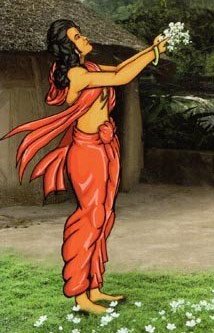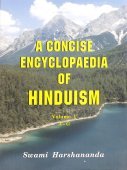Putrika, Putrikā: 12 definitions
Introduction:
Putrika means something in Buddhism, Pali, Hinduism, Sanskrit, Marathi, Hindi. If you want to know the exact meaning, history, etymology or English translation of this term then check out the descriptions on this page. Add your comment or reference to a book if you want to contribute to this summary article.
In Hinduism
Purana and Itihasa (epic history)
Source: archive.org: Shiva Purana - English TranslationKuputra (कुपुत्र) refers to a “daughter”, according to the Śivapurāṇa 2.3.30 (“The Celebration of Pārvatī’s Return”).—Accordingly, as Brahmā narrated to Nārada: “On hearing that Pārvatī was returning, Menā and Himavat excessively delighted went ahead seated in a divine vehicle. [...] O great sage, ladies performed her ceremonial ablution; the brahmins offered benedictions. Himvat and Menakā rejoiced much. Himavat considered his household life fruitful. A daughter (putrikā) is far better than an ignoble son. He praised you too, Nārada, saying ‘Well done, Well done’. [...]”.
Source: Cologne Digital Sanskrit Dictionaries: The Purana IndexPutrikā (पुत्रिका).—An Apsaras.*
- * Vāyu-purāṇa 69. 5.

The Purana (पुराण, purāṇas) refers to Sanskrit literature preserving ancient India’s vast cultural history, including historical legends, religious ceremonies, various arts and sciences. The eighteen mahapuranas total over 400,000 shlokas (metrical couplets) and date to at least several centuries BCE.
Kavya (poetry)
Source: academia.edu: Bhoja’s Mechanical GardenPutrikā (पुत्रिका) refers to the “wooden dolls” as mentioned in the Kathāsaritsāgara.—Miniature things were typically endearing in the world of Sanskrit courtly literature, and here the automaton and the toy have strong aesthetic (and linguistic) convergences. In fact the terms used for both the mechanical and magical automata reveal that they were first and foremost conceived of as dolls, puppets, or figurines. One is reminded of the damsel Somaprabhā’s little basket (karaṇḍikā) of wooden dolls (dārumaya... putrikā) brought to entertain her friend Kaliṅgasenā in Somadeva’s eleventh-century Kathāsaritsāgara. These wooden putrikās—perceptively translated at one point by Tawney as “toys”—are further described by Somadeva as both “magical” and “mechanical” (māyāyantra-putrikā), for with the pull of a pin (kīlikā), they performed amazing tasks like flying through the air to fetch garlands or water or dancing and conversing on command.
Their (viz., the wooden putrikās’) speaking capacities are reminiscent not only of the speaking automaton in Bhoja’s Śṛṅgāramañjarīkathā but also of contemporary tenth-and eleventh-century story cycles (some involving Bhoja) dealing with the famous throne of King Vikramāditya of yore that was furnished with speaking figurines or dolls (puttalikā) on its base.

Kavya (काव्य, kavya) refers to Sanskrit poetry, a popular ancient Indian tradition of literature. There have been many Sanskrit poets over the ages, hailing from ancient India and beyond. This topic includes mahakavya, or ‘epic poetry’ and natya, or ‘dramatic poetry’.
In Buddhism
Tibetan Buddhism (Vajrayana or tantric Buddhism)
Source: academia.edu: The Structure and Meanings of the Heruka MaṇḍalaPutrikā (पुत्रिका) is the name of a Ḍākinī who, together with the Vīra (hero) named Putra forms one of the 36 pairs situated in the Agnicakra, according to the 10th century Ḍākārṇava chapter 15. Accordingly, the agnicakra refers to one of the three divisions of the saṃbhoga-puṭa (‘enjoyment layer’), situated in the Herukamaṇḍala. The 36 pairs of Ḍākinīs [viz., Putrikā] and Vīras are red in color; they each have one face and four arms; they hold a skull bowl, a skull staff, a small drum, and a knife.

Tibetan Buddhism includes schools such as Nyingma, Kadampa, Kagyu and Gelug. Their primary canon of literature is divided in two broad categories: The Kangyur, which consists of Buddha’s words, and the Tengyur, which includes commentaries from various sources. Esotericism and tantra techniques (vajrayāna) are collected indepently.
Languages of India and abroad
Marathi-English dictionary
Source: DDSA: The Molesworth Marathi and English Dictionaryputrikā (पुत्रिका).—f S putrī f (S) A daughter. 2 A doll, a puppet, a little image.
Source: DDSA: The Aryabhusan school dictionary, Marathi-Englishputrikā (पुत्रिका).—f putrī f A daughter.
Marathi is an Indo-European language having over 70 million native speakers people in (predominantly) Maharashtra India. Marathi, like many other Indo-Aryan languages, evolved from early forms of Prakrit, which itself is a subset of Sanskrit, one of the most ancient languages of the world.
Sanskrit dictionary
Source: DDSA: The practical Sanskrit-English dictionaryPutrikā (पुत्रिका).—
1) A daughter.
2) A doll, puppet.
3) A daughter appointed to raise male issue for a father who has no sons; अपुत्राऽ नेन विधिना सुतां कुर्वीत पुत्रिकाम् । यदपत्यं भवेदस्यां तन्मम स्यात् स्वधाकरम् (aputrā' nena vidhinā sutāṃ kurvīta putrikām | yadapatyaṃ bhavedasyāṃ tanmama syāt svadhākaram) || Manusmṛti 9.127.
4) The cotton or down of the tamarisk.
6) A small statue; तद्धाम्नाऽभूदजस्तूष्णीं पूर्देव्यन्तीव पुत्रिका (taddhāmnā'bhūdajastūṣṇīṃ pūrdevyantīva putrikā) Bhāgavata 1.13.56.
6) (At the end of comp.) Anything little or small of its kind; as in असिपुत्रिका, खड्गपुत्रिका (asiputrikā, khaḍgaputrikā) &c.
See also (synonyms): putrakā.
Source: Cologne Digital Sanskrit Dictionaries: Monier-Williams Sanskrit-English Dictionary1) Putrikā (पुत्रिका):—[from putra] f. a daughter ([especially] a d° appointed to raise male issue to be adopted by a father who has no sons), [Manu-smṛti; Mahābhārata] etc.
2) [v.s. ...] a puppet, doll, small statue, [Bhartṛhari; Kathāsaritsāgara]
3) [v.s. ...] (ifc. = a diminutive; cf. asikhaḍga.)
4) [v.s. ...] the cotton or down of the tamarisk, [Horace H. Wilson]
Source: DDSA: Paia-sadda-mahannavo; a comprehensive Prakrit Hindi dictionary (S)Putrikā (पुत्रिका) in the Sanskrit language is related to the Prakrit words: Puttaliyā, Puttalī, Puttiā.
[Sanskrit to German]
Sanskrit, also spelled संस्कृतम् (saṃskṛtam), is an ancient language of India commonly seen as the grandmother of the Indo-European language family (even English!). Closely allied with Prakrit and Pali, Sanskrit is more exhaustive in both grammar and terms and has the most extensive collection of literature in the world, greatly surpassing its sister-languages Greek and Latin.
Hindi dictionary
Source: DDSA: A practical Hindi-English dictionaryPutrikā (पुत्रिका):—(nf) a daughter; puppet, doll.
...
See also (Relevant definitions)
Starts with: Putrikabhartri, Putrikadharma, Putrikapati, Putrikaprasu, Putrikapurvaputra, Putrikaputra, Putrikar, Putrikarana, Putrikaranamimamsa, Putrikashena, Putrikasuta.
Ends with (+8): Amushyaputrika, Apangaputrika, Aputrika, Asiputrika, Avaputrika, Bahuputrika, Bhimaputrika, Candanaputrika, Citraputrika, Daruputrika, Devaputrika, Dharmaputrika, Gramaputrika, Gridhraputrika, Haputrika, Karnaputrika, Khadgaputrika, Khangaputrika, Kritrimaputrika, Niputrika.
Full-text (+37): Pautrikya, Pautrika, Asiputrika, Daruputrika, Khadgaputrika, Rajaputrika, Putraka, Aputrika, Yantraputraka, Phanjiputrika, Putrikabhartri, Putrikaprasu, Vastraputrika, Putrikasuta, Pautrikeya, Yantraputrika, Putrikaputra, Kilika, Putrikapurvaputra, Kritrimaputraka.
Relevant text
Search found 15 books and stories containing Putrika, Putrikā; (plurals include: Putrikas, Putrikās). You can also click to the full overview containing English textual excerpts. Below are direct links for the most relevant articles:
Harshacharita (socio-cultural Study) (by Mrs. Nandita Sarmah)
1. Similarities (5): Economic Condition < [Chapter 8 - Comparative Society as described in the Kādambarī and the Harṣacarita]
Manusmriti with the Commentary of Medhatithi (by Ganganatha Jha)
Verse 9.128 < [Section XVII - Property of one who has no Male Issue: the ‘Appointed Daughter’]
Verse 9.127 < [Section XVII - Property of one who has no Male Issue: the ‘Appointed Daughter’]
Bhakti-rasamrta-sindhu (by Śrīla Rūpa Gosvāmī)
Verse 2.3.24 < [Part 3 - Involuntary Ecstatic Expressions (sattvika-bhāva)]
The Garuda Purana (by Manmatha Nath Dutt)
Chapter LXXI - Tests of Emerald < [Agastya Samhita]
Garga Samhita (English) (by Danavir Goswami)
Verse 2.15.25 < [Chapter 15 - Description of Śrī Rādhā-Kṛṣṇa’s Falling in Love]
Trishashti Shalaka Purusha Caritra (by Helen M. Johnson)
Part 1: Vasudevahiṇḍi (the wanderings of Vasudeva) < [Chapter IV - Vasudevahiṇḍi]
Appendix 5.2: new and rare words < [Appendices]
Related products
